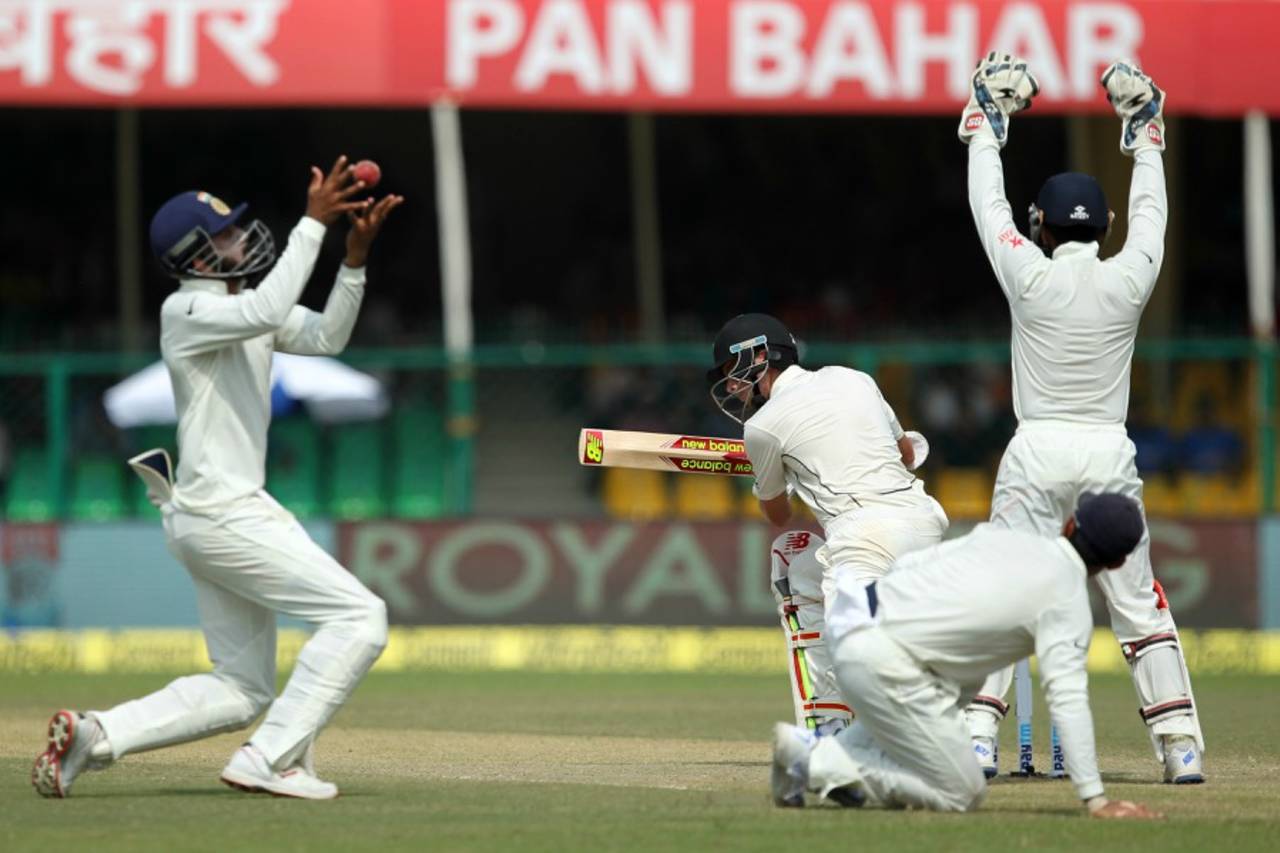Tidy India tighten grip, loose NZ lose theirs
An analytical look at the sequences of play that shaped day three in Kanpur, and turned the Test India's way

Dot balls lead to wickets, as India learnt on day three • BCCI
Nineteen dot balls led to a wicket. India's spinners bowled 31 overs on the second day and managed only two maidens. On day three, they bowled two maidens in the first four overs and the result was telling. There's always a particular bit of advice floating around the field in Test matches - "stitch the dots together" - and that invariably leads to wickets.
Both Tom Latham and Ross Taylor played for the turn and got beaten by the one that went straight after pitching, and that's not the batsmen's fault. When most balls are gripping the surface and turning, you tend to play outside or inside the line depending on the bowler. For example, you plant the front foot a little across for the bowlers who are taking the ball away from you, and go a lot straighter for the bowlers who are bringing the ball into you. Ideally you keep the bat in front of the pad to take care of the straighter ones, but that is not always possible and is especially tougher to do early on in your innings.
Two and a half days into the Test match, on a dry pitch in the subcontinent, and there had not been any reverse swing on show. After the first day, the consensus was that New Zealand failed to maintain the shine on the ball, which can be attributed to it being early days on the tour. For the ball to reverse swing, it's imperative to keep the ball dry as well as shine one side. But that is a little difficult to do in hot and humid conditions, and New Zealand's bowlers and fielders might have passed some moisture onto the ball unwittingly. But the same can't be true for India's bowlers and fielders, for they are well versed with the conditions and its demands. The verdict thus far: the SG Test balls used in this Test have not produced any reverse swing.

The fundamental difference between sporting pitches in the subcontinent and elsewhere is that here it's almost certain that one wicket will bring a few more, and Kanpur is no different. New Zealand were only 63 runs behind with five wickets in hand but the moment one wicket fell, the collapse started.
The ball had spun from the first session of the first day. As the match progressed, the rough became prominent and by the third session, you could see a puff of dust every time the ball pitched outside off for the right-hand batsmen. Considering this, you might have wondered why none of the captains opted to place a fielder close to the bat on the off side. Setting the field in a Test match is a part of the larger strategy: you plug certain holes and leave some unplugged intentionally to tempt the batsman. That's exactly why there was not a fielder at silly point for offspinners; the idea was to encourage the batsman to go across in order to play the ball against spin, which in turn is likely to induce the inside edge. So far, though, no batsman has fallen for it.
Session breaks are considered to be partnership breakers, as it is not only tougher for batsman to start afresh but the interval also allows bowlers to rest their shoulders. In this case, New Zealand were even better placed because KL Rahul fell at the stroke of tea. But instead of starting strongly, their spinners dished out a flurry of ordinary balls to which India's batsmen responded positively. At least five of the seven boundaries they hit in eleven balls were either half-volleys, full tosses or rank long hops. Both Cheteshwar Pujara and M Vijay are too good to miss out on those. New Zealand were rapidly losing their grip on the match.

New Zealand played one more spinner than India but were forced to go to Martin Guptill in the 28th over. Once the pitch slows down, the need for consistency with regards to speed and length increases manifold. The only option for variation you still have is with the lines. In the second innings, the New Zealand spinners have not been consistent enough to create pressure. On the other hand, India's batsmen have been significantly more aggressive in punishing the loose balls and decisive with their foot movement.
Towards the end of day's play, Kane Williamson used Mitchell Santner and Ish Sodhi to bowl from over and around the stumps respectively, into the rough outside right-hand batsmen's leg stump. While it's a great idea to change the angles and pose different questions, the execution of the plan left a lot to be desired. Once you target the rough outside leg, you must force the batsman to play almost everything off the front foot and, also, bowl a foot or more outside leg stump. Sodhi did bowl a foot outside leg, but he was a little too short and that allowed the batsmen to negate the threat by playing off the back foot. While Santner bowled a lot fuller, he kept pitching in the undamaged area of the pitch; instead of targeting the rough outside leg, he bowled a lot straighter. It's unfair to blame them for this, though, for setting up a leg trap is an art that needs mastering; it can only happen if you've done it a lot of times in your career.
Aakash Chopra is the author of three books, the latest of which is The Insider: Decoding the craft of cricket. @cricketaakash